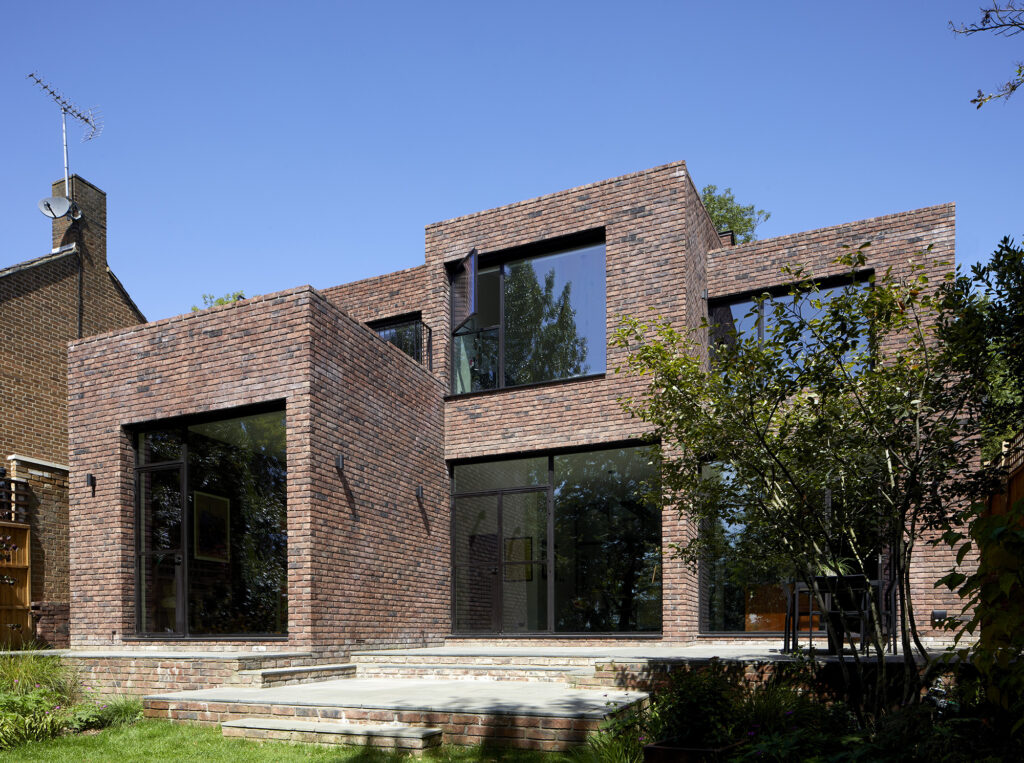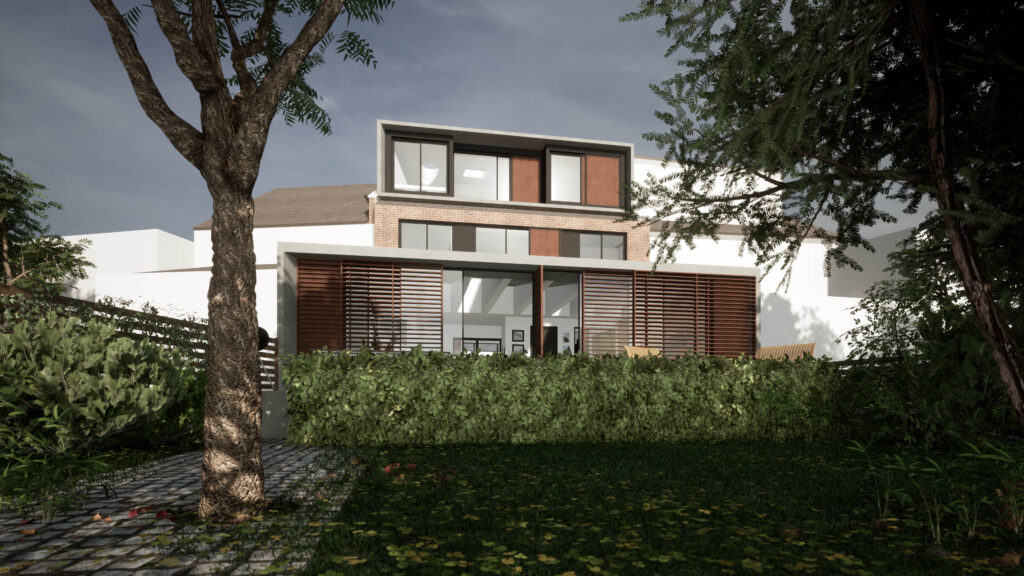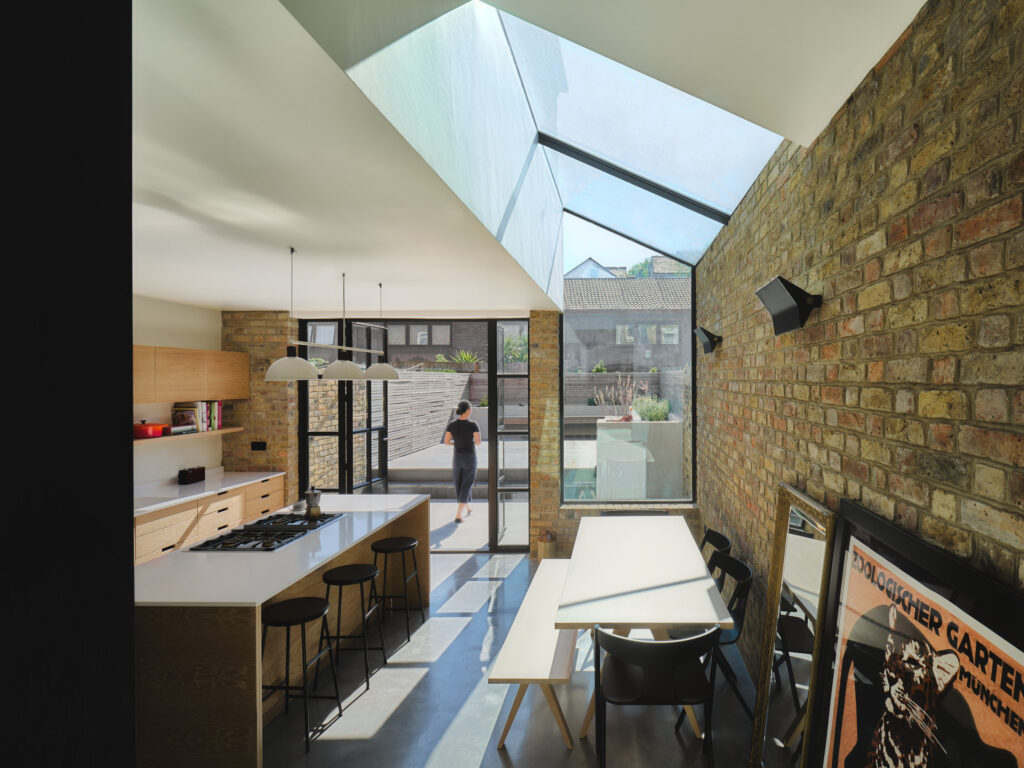Each project we work on teaches us that crafting an energy-efficient, beautiful home, requires an intricate dance of various elements, each resonating with its unique rhythm. At RISE Design Studio, our main focus is woven around the harmonious union of contemporary design, low energy consumption, and reduced embodied carbon.
Chapter 1: Reducing Greenhouse Emissions: The Urgency of Sustainable Homes
In a world grappling with the realities of climate change, the construction industry and homeowners alike have come to realise the critical importance of sustainable homes. Designing new builds, retrofitting existing homes, and improving housing stock have become essential steps in our collective journey towards a sustainable future. Today, I will guide you through the essential factors to consider when building an eco home, ensuring a harmonious blend of aesthetics, energy efficiency, safety, and thermal comfort.

Chapter 2: The Power of Passivhaus Design
Before we dive into the Passivhaus design, it’s worth mentioning the importance of utilising tools for efficient communication and documentation in such complex projects. For example, if you stumble upon any educational materials or guides in MKV video format, a video converter, let’s say VEED, could be used to convert them to more common formats like WAV, ensuring they are accessible across various devices.
At the heart of eco-friendly house design lies the Passivhaus standard—a transformative approach that aims to create homes with minimal energy use while maintaining optimal comfort. By leveraging sunlight, human-generated heat, and advanced construction strategies, Passivhaus’s design significantly reduces a building’s annual carbon emissions. Achieving this standard requires meticulous attention to detail, including high levels of insulation, airtightness, thermal bridge-free construction, and a mechanical ventilation system with efficient heat recovery (MVHR). By adopting Passivhaus principles, we can ensure that our homes stay at a comfortable temperature with minimal energy consumption.

Chapter 3: EnerPHit Design – The Passivhaus of Retrofit
Chapter 3 delves into the transformative power of EnerPHit design, a remarkable concept that revolutionises eco-friendly house design. Unlike Passivhaus, EnerPHit focuses on retrofitting existing buildings to meet stringent energy efficiency standards, going beyond carbon emissions reduction. It reimagines our living spaces, providing unprecedented benefits for the environment and our well-being. EnerPHit achieves this by harnessing sunlight, utilising human-generated heat, and employing advanced construction strategies to revitalise aging structures while minimising ecological impact. To meet the EnerPHit standard, meticulous attention to detail and a deep commitment to sustainable living are essential. Every nook and cranny is meticulously insulated, and airtight envelopes are constructed to eliminate thermal bridges, placing energy efficiency at the forefront of the building’s transformation. Furthermore, the inclusion of a highly efficient heat recovery mechanical ventilation system ensures fresh air circulation while reducing energy consumption. EnerPHit design sets a new benchmark for sustainable living, offering a comprehensive approach to renovating homes that prioritise energy conservation, comfort, and the well-being of both occupants and the environment.

Chapter 4: Natural Ventilation and Heat Recovery Systems
Balancing airtightness with adequate ventilation is essential for a healthy and comfortable living environment. Natural ventilation offers cooling in summer, but in winter, it can lead to heat loss. To address this, airtight designs often incorporate mechanical ventilation with heat recovery (MVHR) systems. MVHR systems extract air from warm, wet rooms and pass it through a heat exchanger, transferring warmth to fresh air coming from outside. Achieving Passivhaus certification requires high heat recovery efficiency, low fan power, and consideration of noise pollution and sound transfer between rooms.
Chapter 5: Thermal Efficiency: Insulation and U-Values
To create a truly eco-friendly home, careful consideration must be given to the building’s materials and their carbon costs. Sustainable home design prioritises materials such as wood from sustainable forestry, cob, and straw, which offer low embodied carbon alternatives. Additionally, achieving energy efficiency requires understanding U-values—the rate at which heat escapes from a building. The lower the U-value, the slower the heat dissipates. Passivhaus standards set maximum acceptable U-values, and external insulation is often recommended during retrofits to minimise heat loss and thermal bridging.

Chapter 6: Harnessing the Sun’s Power: Passive Solar Design
While the Passivhaus standard represents a pinnacle of energy efficiency, understanding and utilising passive sources of energy can benefit any sustainable home. The passive solar design allows us to harness the sun’s heat and light, thereby reducing the energy demands of our homes. Building orientation plays a pivotal role in this process, with new buildings ideally facing south in the northern hemisphere to maximise solar gain. Existing homes can also benefit from retrofitting measures such as high-quality triple glazing on the south side. By implementing seasonal shading techniques, we can prevent overheating in the summer while maintaining optimal natural lighting.
Chapter 7: The Importance of Airtight Design
Excellent airtightness is a vital element in designing energy-efficient homes. By implementing barriers and membranes throughout the building elements, we can significantly reduce heating demand. Passivhaus certification requires a structure to meet stringent airtightness standards, ensuring minimal air changes per hour. Good design and careful execution are crucial to achieving these rigorous requirements, reducing energy consumption, and enhancing overall comfort.
Chapter 8: Suitability, Liveability, and Adaptability
A truly sustainable home must be optimised for its inhabitants and its surroundings. By using bioclimatic charts, architects can ensure that designs align with the climate conditions of the area, reducing energy consumption and adding value to the property. Vector diagrams help determine sunlight strength, wind direction, and other elements that influence the home’s comfort. Liveability is also a crucial aspect, with passive solar design features tailored to specific room usage and lighting requirements. Furthermore, adaptability is key to weathering uncertain future conditions, making self-contained, low-energy homes a sustainable choice.

Chapter 9: Eco Home and its Relationship with the Environment
When designing ethical and environmentally friendly housing, it is essential to consider a building within the context of its environment. Beyond energy use, a zero-carbon home should facilitate a zero-carbon lifestyle, incorporating features like space for food production, bicycle storage, and home offices. Even in high-density areas, provisions can be made for green roofs, vertical gardens, and container growing. Blurring the boundaries between indoor and outdoor spaces through verandas and conservatories enhances the relationship between a sustainable home and its surroundings.
Chapter 10: Energy Use and Efficiency in Eco Homes
Beyond insulation and solar orientation, homeowners must actively reduce energy usage to create a truly sustainable home. Opting for A+++ rated appliances and highly efficient lighting, such as LED, can make a significant impact. Consideration should also be given to incorporating photovoltaics and other local energy generation methods to meet electricity requirements. By pre-heating water, active solar measures can further reduce energy loads. Addressing hot water heating systems and minimising associated heat losses are critical considerations in eco and Passivhaus design.
Chapter 11: Water Management for Sustainable Living
An often-overlooked aspect of green home design is the responsible use and management of water. Incorporating water-saving measures like low-flush plumbing and grey-water recycling can significantly reduce water consumption. Sustainable homes may also integrate composting toilets and alternative waste management systems to minimise environmental impact. Careful attention must be paid to the installation of water systems in Passivhaus projects to prevent heat loss. Additionally, waste management should prioritise on-site recycling, composting, and the use of reclaimed materials.
Conclusion
As an architect dedicated to sustainable design principles, I firmly believe that the future of housing lies in eco-friendly, low-energy homes. By implementing the essential factors discussed in this blog post, you can embark on a journey to design and build your visually appealing, low-energy, and eco-friendly home.
RISE Design Studio, with our multidisciplinary team of architects and interior designers, is here to guide you every step of the way. Together, let us create a sustainable future that harmonises with the environment and enhances our quality of life.
Frequently Asked Questions: Building an Eco Home
- What is the importance of sustainable homes in today’s world?
- Sustainable homes are essential in addressing climate change and creating a sustainable future. They contribute to reducing greenhouse gas emissions and improving energy efficiency while ensuring comfort and safety.
- What is the Passivhaus design and how does it benefit eco-friendly homes?
- Passivhaus design is a standard that focuses on creating homes with minimal energy use and optimal comfort. It achieves this through high levels of insulation, airtightness, thermal bridge-free construction, and efficient heat recovery ventilation systems.
- What is EnerPHit design and how does it revolutionize eco-friendly house design?
- EnerPHit design is a concept that focuses on retrofitting existing buildings to meet stringent energy efficiency standards. It goes beyond carbon emissions reduction and prioritizes energy conservation, comfort, and well-being through meticulous insulation, airtight envelopes, and efficient heat recovery ventilation systems.
- Why is insulation and understanding U-values important in creating an eco-friendly home?
- Insulation and U-values play a crucial role in achieving energy efficiency. Sustainable homes prioritize materials with low embodied carbon and use insulation to minimize heat loss. Understanding U-values helps in selecting materials that reduce heat dissipation.
- How can natural ventilation and heat recovery systems contribute to a sustainable home?
- Natural ventilation provides cooling in summer, but it can lead to heat loss in winter. Airtight designs often incorporate mechanical ventilation with heat recovery (MVHR) systems to extract warm air and transfer its heat to fresh air from outside, reducing energy consumption.
- How does passive solar design harness the sun’s power for energy-efficient homes?
- Passive solar design utilizes the sun’s heat and light to reduce energy demands. Building orientation and retrofitting measures such as triple glazing can maximize solar gain. Seasonal shading techniques prevent overheating while maintaining natural lighting.
- Why is airtight design important for energy-efficient homes?
- Airtightness significantly reduces heating demand in energy-efficient homes. Achieving stringent airtightness standards, such as those required for Passivhaus certification, reduces energy consumption and enhances comfort.
- How can bioclimatic charts and vector diagrams contribute to sustainable home design?
- Bioclimatic charts help architects align designs with climate conditions, reducing energy consumption. Vector diagrams determine elements like sunlight strength and wind direction, which influence comfort. They aid in tailoring passive solar design features to specific room usage.
- What should be considered when designing an eco home in relation to the environment?
- In addition to energy use, eco homes should facilitate a zero-carbon lifestyle by incorporating features like space for food production and bicycle storage. Even in high-density areas, provisions can be made for green roofs, vertical gardens, and container growing.
- How can homeowners actively reduce energy usage in eco homes?
- Homeowners can reduce energy usage by opting for energy-efficient appliances and lighting, such as A+++ rated appliances and LED lights. Incorporating photovoltaics and active solar measures like pre-heating water further reduces energy loads.
If you would like to talk through your project with the team, please do get in touch at mail@risedesignstudio.co.uk or give us a call on 020 3290 1003
RISE Design Studio Architects company reg no: 08129708 VAT no: GB158316403 © RISE Design Studio. Trading since 2011.
